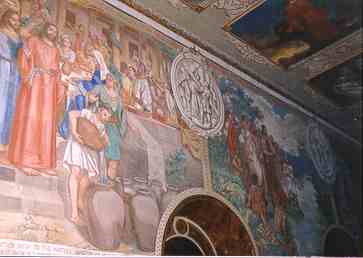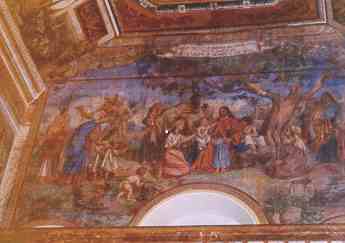 |
A short visit on a holiday
 |
Through the Entrance "Main Gate" from the road, the Auditorium and Canteen Buildings are just visable on the right hand side.
 |
A view of the St. Aloysius College building which is on your right when you enter, and can be viewed through the basketball courts. ( Sorry I was running out of time hence very rushed pictures, as there were about 60 of us visiting the College!!)
 |
Still looking on your right as you keep walking , ( the left side is a road that leads you to the Hostel and High School Grounds) youwill see the Portico in front of the Chapel. It is a white structure, but because of the weather in Mangalore seems to have lost some of it's whiteness.
 |
As you pass this beautiful edifice, you come straight to the Aloysius High School (below), and the Father's Quarters. (Having to obtain permission to visit the Chapel as it was a Sunday, we went upstairs to the Father's quarters, and I did take a photo of the view of Mangalore from the balcony. As it was sun going down directly opposite me, I got a very hazy photo, oops,sorry!)
 |
Below, a view of Mangalore at around 5.30 p.m. from the Balcony of the Fathers Quarters.
 |
The Chapel
Inside the Chapel, one is taken to another dimension. Having being told that one 'must' visit St. Aloysius College and see the 'paintings', it was not clear what to expect. On entering the Chapel, the bright light of the outside is cut off and the eyes gradually refocus and the colours start mixing together, I was totally taken by surprise, and did not know where to start looking (remember I was with a fairly large group who also wanted to go shopping also, so I had to decide to spend some time or just look around. Totally I must have spent about 45 mins in the Chapel where I would have needed at least 3 hours to enjoy each and every painting) so I just went up to the front and took the Altar and then moved across one wall (moving to the right) around the whole Chapel back to the Altar approaching from the left. When I went up to get some information on the Chapel, I had a chance to take a few shots of teh roof and the painting on the Chapel loft. Here goes, please excuse me as I was not equipped to take the ceiling brightly as it was quite high and you need a powerful flash, you may find some if the photos slightly under exposed. Later, I will also include some of the photos from the Souvenir & Guide given to me by Fr. Rasquinha s.j. and will also give the write-up on the Chapel.
 |
 |
Extracts from the Souvenir of the Chapel describing the Chapel Paintings.
THE CEILING OF THE NAVE
The central row of paintings on the ceiling depicts the life of Aloysius Gonzaga to whom this College and Chapel is dedicated. Aloysius was the eldest son and heir the Marquis of Castiglione in Italy. He wanted to lead a religious life in order to serve his fellow men. Therefore he gave his right to the marquisate to his younger brother. This event is depicted in the fourth (from the rear) painting on the ceiling. Aloysius, dressed in black, hands over his sword to his. younger brother. His mother presides over the ceremony. The lawyer and his clerk write down the deed and curious servants -are witnessing the event.
His earlier life is shown in the first three panels from the rear:
The fifth panel shows Aloysius seeking admission to the Jesuit Order.
The rest of his life is depicted on the wall above the altar. The central picture depicts him serving the plague stricken in Rome. Aloysius volunteered to help the plague stricken. He contracted the disease and died, at the young age of 23 years.
This young man who gave his life in the service of others is given as a model to the 5,000 young people studying on this campus. Aloysius had everything that a young man of his age desires. He had wealth, power and influence. But he gave them up in order to serve others, especially the most needy. Our students are asked to imbibe his spirit of service.
THE SLOPING PORTION OF THE CEILING
On the panels of the sloping portion of the ceiling are portrayed the Apostles. Note the garlands weaving through the different panels. No two garlands have the same flowers. The angels who hold the garland are life size.
THE ARCHES OF THE NAVE
The Series of the Upper Arches, depict saints of the Church.
The lower arches depict Jesuit saints.
The painting on the rear wall shows Jesus as the friend of children. It is considered to be the masterpiece of Moscheni. Due to seepage of rain water the painting was covered with fungus and calcium carbonate crystals. It has now been restored but a patch of the unrestored painting has been left untouched below the woman seated at the right.
THE SANCTUARY
THE SANCTUARY is the raised part above the flight of steps. Visitors are not allowed to go up there.
At the foot of this great arch, on the left stands ST IGNATIUS OF LOYOLA (1491-1556), Founder of the Jesuit Order.
The left and right Aisles take up the life of. Jesus.
THE MAKING OF A MASTERPIECE
How the Chapel was painted:
There are two types of paintings in the Chapel: fresco and canvas. A fresco is painted on fresh wet lime plaster walls. The colours get embedded in the lime plaster as it dries up. Frescos cover about 600 square rnetres of the walls of the Chapel. For an oil painting, the colours are made by mixing pigments with linseed oil. The canvas is made of pure linen of strong close weave. The paintings on the ceilings in the Chapel (about 400 Square Metres) are in oil on canvas.
The Restoration of the Paintings:
In recent times the paintings have suffered damage due to the humidity and dust of Mangalore, due to the weight of the dust. The stiches of the canvases had given way. The canvases were taken down with the help of a special cradle, the dust was removed, the pieces were restiched, the joints were reinforced with tapes. After restretching the canvas on the frame the paintings were put back in place. If you look at the second picture from the rear, which shows Aloysius as a small boy preaching on the street, there are two white lines across the painting. These are the places where the canvas cloth was torn and has been repaired. The wall paintings were damaged due to rain water sweeping through the walls. They were cleaned using special chemicals. The painting on the rear wall has a small square patch below the place where the woman is kneeling. This patch shows how the painting looked like before restoration. The work of restoration was done by specialists of INTACH - ICI Lucknow from 1991 to 1994 under the guidance of Dr O.P. Agrawal.
THE GENIUS WHO MADE IT POSSIBLE
 |
Antonio Moscheni s.j.
Antonio Moscheni was born in a village called Stezzano near Bergamo in Italy on January 17, 1854. Fortunately for him, his artistic t were discovered early and he was sent to the famed Accademia Carrara in Berganeo. He studied under able masters and acquired considerable proficiency in the art of painting. He the to Rome to study the masterpieces of the Vatican. Fresco painting now became his passion. In 1889, Antonio renounced the pro of a brilliant career and became a religious in the Society of But his religious superiors did not wish his talents to be buried. ordered him to paint several churches in his native place as a Albania and Yugoslavia. They then sent him to Mangalore to the Chapel of St Aloysius College. It took him a little over two to cover the walls and ceilings of the Chapel with frescos a paintings. Later he painted the Holy Name Cathedral in Bombay November 15, 1905 as he was painting a church in Cochin he to see the face of the Divine Master which he had, in various fixed on canvas.
 |
 |
 |
 |
Photo on left below is from the left side of the Altar.
 |
 |
 |
 |
 |
 |
  |
 |
The Sloping portion of the Ceiling, central ceiling depicting the early life of Alousius Gonzaga to whom the Chapel is dedicated.
 |
Wedding Feast of Cana (Outer wall of the left aisle)
 |
Baptism of Jesus at the Jordan (Fresco on left outer wall)
 |
This Page Hosted by ![]() Get Your Own Free Home Page
Get Your Own Free Home Page
Ron's New e-mail: ronniejohnson@hotmail.com (or) ronniejohnson@hotmail.com"